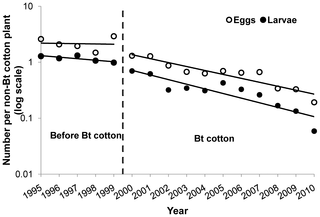

| Visitors Now: | |
| Total Visits: | |
| Total Stories: |

| Story Views | |
| Now: | |
| Last Hour: | |
| Last 24 Hours: | |
| Total: | |
The Halo Effect: Suppression of Pink Bollworm on Non-Bt Cotton by Bt Cotton in China
Abstract
In some previously reported cases, transgenic crops producing insecticidal proteins from Bacillus thuringiensis (Bt) have suppressed insect pests not only in fields planted with such crops, but also regionally on host plants that do not produce Bt toxins. Here we used 16 years of field data to determine if Bt cotton caused this “halo effect” against pink bollworm (Pectinophora gossypiella) in six provinces of the Yangtze River Valley of China. In this region, the percentage of cotton hectares planted with Bt cotton increased from 9% in 2000 to 94% in 2009 and 2010. We found that Bt cotton significantly decreased the population density of pink bollworm on non-Bt cotton, with net decreases of 91% for eggs and 95% for larvae on non-Bt cotton after 11 years of Bt cotton use. Insecticide sprays targeting pink bollworm and cotton bollworm (Helicoverpa armigera) decreased by 69%. Previously reported evidence of the early stages of evolution of pink bollworm resistance to Bt cotton in China has raised concerns that if unchecked, such resistance could eventually diminish or eliminate the benefits of Bt cotton. The results reported here suggest that it might be possible to find a percentage of Bt cotton lower than the current level that causes sufficient regional pest suppression and reduces the risk of resistance.
Citation: Wan P, Huang Y, Tabashnik BE, Huang M, Wu K (2012) The Halo Effect: Suppression of Pink Bollworm on Non-Bt Cotton by Bt Cotton in China. PLoS ONE 7(7): e42004. doi:10.1371/journal.pone.0042004
One figure from the paper:
Figure 3. Pink bollworm abundance on non-Bt cotton before and after adoption of Bt cotton.
Before Bt cotton (1995–1999), annual average abundance did not change significantly for eggs (slope = −0.0048, df = 3, R2 = 0.004, P = 0.92) and larvae (slope = −0.027, df = 3, R2 = 0.64, P = 0.10). With Bt cotton (2000–2010), annual average abundance declined significantly for both eggs (slope = −0.070, df = 9, R2 = 0.86, P<0 .0001=".0001" and="and" df="9,
2012-08-01 15:45:44
Source: http://gmopundit.blogspot.com/2012/08/plos-one-halo-effect-suppression-of.html
Source:



